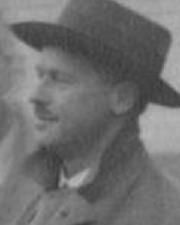Ludwig Bieberbach
| Ludwig Bieberbach | |
|---|---|

1930 at Jena
|
|
| Born |
4 December 1886 Goddelau, Grand Duchy of Hesse, German Empire |
| Died | 1 September 1982 (aged 95) Oberaudorf, Upper Bavaria, West Germany |
| Nationality | German |
| Fields | Mathematics |
| Institutions |
University of Berlin University of Frankfurt |
| Alma mater |
University of Göttingen University of Heidelberg |
| Doctoral advisor | Felix Klein |
| Doctoral students |
Hubert Cremer Werner Fenchel Maximilian Herzberger Heinz Hopf Kurt Schröder Wilhelm Süss |
| Known for | Fatou–Bieberbach domain |
Ludwig Georg Elias Moses Bieberbach (German: [ˈbiːbɐˌbaχ]; 4 December 1886 – 1 September 1982) was a German mathematician.
Born in Goddelau, near Darmstadt, he studied at Heidelberg and under Felix Klein at Göttingen, receiving his doctorate in 1910. His dissertation was titled On the theory of automorphic functions (German: Theorie der automorphen Funktionen). He began working as a Privatdozent at Königsberg in 1910 and as Professor ordinarius at the University of Basel in 1913. He taught at the University of Frankfurt in 1915 and the University of Berlin from 1921–45.
Bieberbach wrote a habilitation thesis in 1911 about groups of Euclidean motions – identifying conditions under which the group must have a translational subgroup whose vectors span the Euclidean space – that helped solve Hilbert's 18th problem. He worked on complex analysis and its applications to other areas in mathematics. He is known for his work on dynamics in several complex variables, where he obtained results similar to Fatou's. In 1916 he formulated the Bieberbach conjecture, stating a necessary condition for a holomorphic function to map the open unit disc injectively into the complex plane in terms of the function's Taylor series. In 1984 Louis de Branges proved the conjecture (for this reason, the Bieberbach conjecture is sometimes called de Branges' theorem). There is also a Bieberbach theorem on space groups. In 1928 Bieberbach wrote a book with Issai Schur titled Über die Minkowskische Reduktiontheorie der positiven quadratischen Formen.
...
Wikipedia
